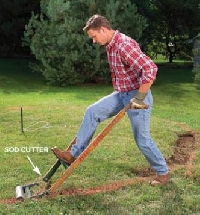Converting grass to garden
By Catalogs Editorial Staff

Converting grass to garden is possible following these steps and precautions
You?ve got a big, grassy yard and you would love to turn a portion of it or maybe all of it into a garden.
One reason people are converting their lawns to gardens is because they want to have access to sufficient fresh food. Another is a quest to reduce water usage; regularly watering or sprinkling a lawn can get expensive.
How do you do it? There are several methods for converting grass to a garden.
SOD CUTTER
Rent a sod cutter and get to work breaking up the soil in the area that you want to transform into a garden. This is going to make you sweat. It is hard work but you will end up with a garden area.
DIG UP THE SOIL BY HAND
Forget the sod cutter and dig up the soil and flip it over. Again, this is back-breaking work but you will end up with an area that can be turned into a garden.
~
SHEET MULCHING
There is a method called sheet mulching. Cover the area that you want to turn into a garden with sheet of cardboard. There shouldn?t be any tape or glue on the cardboard. If you don?t have cardboard, use natural rugs, or old cotton sheets.
Put a cover of mulch or wood chips over the cardboard. Rip or cut a hole or holes in the cardboard exactly where you want to put your plants. Wait 30 days and then start planting.
ROTO-TILL
If you have an extremely large area that you want to convert to a garden area, you will need to roto-till it which requires a power roto-tiller. The soil can?t be too wet because that will create clods of dirt.
After you till, water the area. In three weeks, you need to till again but till it shallowly. Repeat this process once or twice more until the grass seed reserves have been completely exhausted. When you roto-till invasive grasses this can chop up the existing roots and new plants may sprout.
PRECAUTIONS
Before you convert any grassy area into a vegetable garden area you need to check the soil for chemical pesticides and herbicides. An area of soil that has been conventionally farmed or gardened using chemicals takes time to be converted to organic standards. The time the conversion takes depends on how much and what type of chemicals have been used on the grass, the type of soil and how long its been since the grass was last treated with chemicals.
Contact your area County Cooperative Extension office. The extension agent can instruct you on how to locate a soil testing laboratory and how to take soil samples.
When you take the samples from the grass area, wear a face mask, gloves and other protective gear in case there are a potentially dangerous chemicals in the soil. Do not inhale the dust and wash your hands and clothing after you have finished the process.
If is turns out that the area is okay to be transitioned into a garden area, Ideally, you should plant a beneficial cover crop in the spring or early in the summer, such as buckwheat and a legume. The latter repairs the nitrogen level in the soil and the former provides vegetative matter. At the end of the season, these crops should be cut down
After cutting down the crops work them into the soil. Now it?s time to plant rye or another winter cover crop. The winter cover crop shelters the soil from rain, wind and erosion.
Popular Savings Offers
For the next three years, plant a cover crop while always taking soil tests both in the spring and fall. Repeat this process until the grassy area is free of dangerous chemicals, at which time it is safe to turn the area into a vegetable garden.











